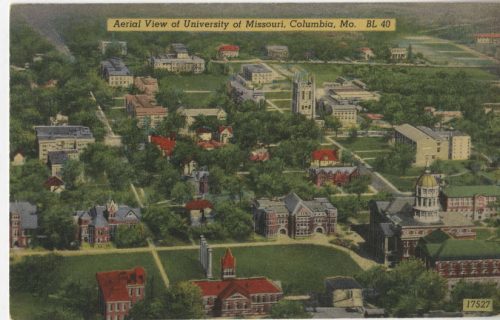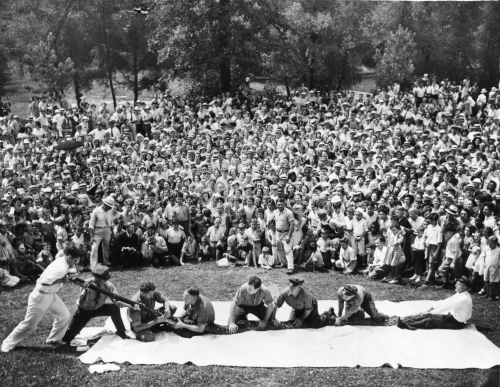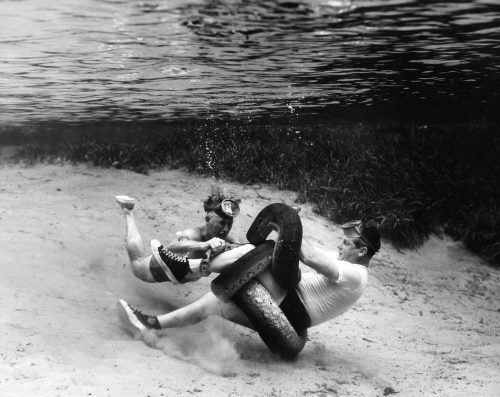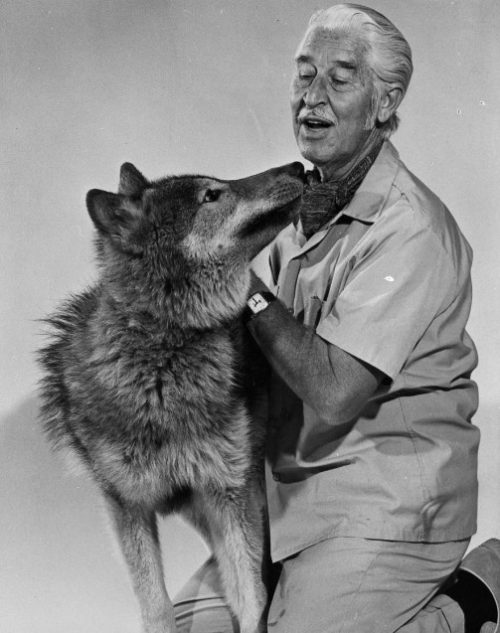![S0516_1862 Marlin Perkins in red scuba gear, on Laysan Island, preparing to snorkel with monk seals in 1977. [Marlin Perkins Papers (S0516)]](https://historicmissourians.shsmo.org/wp-content/uploads/2024/08/S0516_1862-scaled-500x600.jpg)
Marlin Perkins
Introduction
Marlin Perkins was a zoologist and television host from Carthage, Missouri. Starting out as a groundskeeper at the St. Louis Zoo, Perkins became the director of the Buffalo Zoological Gardens, Chicago’s Lincoln Park Zoo, and the St. Louis Zoo, and was famous around the world as the host of the television series Zoo Parade and Mutual of Omaha’s Wild Kingdom.
Early Years
Richard Marlin Perkins was born on March 28, 1905, in Carthage, Missouri, to Mynta Mae (Miller) Perkins and Joseph Dudley Perkins. He was the youngest in the family and had two older brothers. His father was a lawyer and served several terms as Jasper County circuit court judge. In 1912, when Perkins was seven years old, he developed pneumonia, and though he eventually recovered, his mother passed away from the illness. After her death, Perkins went to live with his aunt and uncle, Laura and Harvey Black, on their farm in nearby Pittsburg, Kansas.
Fascinated by snakes from a young age, Perkins made his own zoo in a crawl space under his aunt’s house and kept animals that included “possums, raccoons, turtles, frogs, baby coyotes, anything I could find.” The time spent with animals on the farm left a lasting impression. When he reached the ninth grade, Perkins began attending Wentworth Military Academy, a boarding school in Lexington, Missouri, and the oldest military school west of the Mississippi River. He continued to live with his aunt and uncle when he was not away at school. His father soon remarried, however, and Perkins decided to go back to Carthage to live with him and his new wife.
Education
Upon returning to live with his father, Perkins attended Carthage High School until his graduation in 1923. After a year off to visit his brothers, who now lived in California, he enrolled at the University of Missouri in 1924. Initially studying agriculture, he grew frustrated with his coursework and left the university after two years. Classes in zoology had renewed his interest in wild animals, however, and he decided to look for work with a zoo.
At the Zoo
Not long after leaving the University of Missouri, Perkins decided to apply for a job at the St. Louis Zoo, which agreed to hire him. At first, he worked as a grounds crew member, but after discussing his interest in snakes with the zoo’s director, George Vierheller, Perkins was put in charge of the reptile collection. Under Perkins’s management, the reptile collection grew to more than five hundred animals, and his designs for cages and displays drew large crowds and convinced the zoo’s board of directors to support a permanent reptile exhibition.
While working at the St. Louis Zoo, Perkins had perhaps his most dangerous animal encounter when he was bitten by a West African Gaboon viper, considered to be one of the most poisonous snakes in the world. He described the bite as “like a bee sting magnified 100 times.” Perkins spent three weeks in the hospital, and it took him six months to recover from the bite.
In 1933, Perkins married Elise More. The couple later had a daughter, Suzanne. In 1938, after eleven years as the curator of the St. Louis Zoo’s reptile collection, Perkins left to become the director of the Buffalo Zoological Gardens in Buffalo, New York. In his six years there he greatly expanded the facility. In 1944, Perkins was hired as the director of the Lincoln Park Zoo in Chicago. During his time there, he assisted the famous explorer and mountain climber Sir Edmund Hillary on his 1960 expedition in the Himalayan Mountains in search of the mysterious ape-like creature called the Yeti. Despite the many myths about Yetis, however, it has never been proved that they exist.
"Zoo Parade"
In the years that Perkins was the director of the Lincoln Park Zoo, television was born in the United States. Hoping to connect television viewers with the wonders of nature, Perkins hosted a program called Zoo Parade, on which he exhibited animals from the zoo, taught viewers about each animal, and highlighted topics such as conservation and extinction. While he mostly showed animals from the Lincoln Park Zoo, Perkins also traveled to different locations and zoos. Most of the TV episodes were shown in black and white, but Perkins and the NBC network tried early elements of color television programming in some episodes. Zoo Parade premiered in 1949 and was broadcast nationwide until 1955. The show was nominated for four Emmy awards and won a Peabody Award for children’s programming in 1951. During the years that Zoo Parade was on the air, Perkins divorced his first wife in 1953 and remarried in 1960 to Carol Morse Cotsworth.
"Wild Kingdom"
In 1962, Perkins returned to the St. Louis Zoo to become its director following the retirement of his mentor, George Vierheller. Soon after, Perkins began a long run as the host of the NBC television program Wild Kingdom, later known as Mutual of Omaha’s Wild Kingdom.
On the air from 1963 until 1988, Wild Kingdom made Perkins famous around the world as he and co-host Jim Fowler circled the globe to showcase unique animals and locations, particularly in Africa and along the Amazon River in South America. In addition to animal encounters, Perkins also devoted time to proving that some stories about animals were not true: elephants are not actually scared of mice, vultures can’t smell death, and people can’t charm snakes with music. Perkins left Wild Kingdom in 1985 due to poor health. Jim Fowler continued the show with a new co-host until the show concluded in 1988.
Legacy
During his life, Perkins engaged with millions of people worldwide, both in person and on television, and his devotion to zoology earned him great recognition. Perkins retired as the director of the St. Louis Zoo in 1970 and held the title of director emeritus for the rest of his life. In 1978 the Association of Zoos & Aquariums renamed one of its highest awards the R. Marlin Perkins Award for Professional Excellence in his honor.
In addition to his work at the Buffalo Zoological Gardens, Lincoln Park Zoo, and St. Louis Zoo, he was also an author of several books, including an autobiography titled My Wild Kingdom. Perkins and his wife Carol also devoted much of their lives to the causes of conserving nature and protecting endangered species. In 1971 they worked with Washington University in St. Louis to create the Endangered Wolf Center in Eureka, Missouri, which studies wolves and releases them into their native habitat. A few years later, they helped found the Open Door Animal Shelter in St. Louis. Richard Marlin Perkins passed away from cancer on June 14, 1986. He is buried in Park Cemetery in Carthage, Missouri.
Text and research by Sophie Chappell
References and Resources
For more information about Marlin Perkins’s life and career, see the following resources:
Society Resources
The following is a selected list of books, articles, and manuscripts about Marlin Perkins in the research centers of The State Historical Society of Missouri. The Society’s call numbers follow the citations in brackets.
Articles from the Newspaper Collection
- Barnes, Harper. “Marlin Perkins’ Kingdom.” St. Louis Post-Dispatch. March 10, 1985. p. 1D, 10D.
- Loh, Jules. “Perkins a Unique Creature.” Kansas City Star. March 18, 1979. p. 20A.
- Mace, Bonnie. “Marlin Perkins Recalls Kansas Boyhood.” Kansas City Times. January 8, 1976. p. 2B.
- “Marlin Perkins, Former Resident Here, Selected as Head of St. Louis Zoo.” Carthage Evening Press. April 3, 1962. p. 1.
- Richmond, Dick. “56 Years in the Wild Kingdom: Marlin Perkins’ New Book Ranges from Snakes to Snowmen.” St. Louis Post-Dispatch. December 5, 1982. p. 1D, 12D.
- Sorkin, Michael D. “Carol Perkins: Widow of Zoo Director Marlin Perkins Was Author, Lecturer, Conservationist.” St. Louis Post-Dispatch. October 25, 2012. p. A19.
- “St. Louis Zoo’s Marlin Perkins Dies.” St. Louis Post-Dispatch. June 15, 1986. p. 1A, 13A.
- Christensen, Maxine J. “Marlin Perkins (1905–1986).” Missouri Encyclopedia. Originally published in Dictionary of Missouri Biography, edited by Lawrence O. Christensen, William E. Foley, Gary R. Kremer, and Kenneth H. Winn, p. 606–607. Columbia: University of Missouri Press, 1999. [REF 508 D561]
- Perkins, Carol Morse, and Marlin Perkins. “I Saw You from Afar:” A Visit to the Bushmen of the Kalahari Desert. New York: Atheneum, 1965. [REF IJ P419i]
- Perkins, Marlin. My Wild Kingdom: An Autobiography. New York: E. P. Dutton, 1982. [REF 508.1 P4192]
- Endangered Wolf Center Records (S0535)
The records of the Endangered Wolf Center (formerly the Wild Canid Survival and Research Center) chronicle its establishment, growth, and administration. The collection contains correspondence, meeting minutes, newspaper clippings, articles, publications, legal documents, wolf studies, veterinary reports, conference proceedings, and government legislation. - Marlin Perkins Papers (S0516)
The Marlin Perkins Papers consist of newspaper clippings, correspondence, zoo animal feeding records, business contracts, equipment lists, maps, archaeological records, publications, zoological findings, conservation and ecological writings, scrapbooks, photographs, and film. The materials in this collection are related to Perkins’s involvement in national and international zoos, wildlife and nature conservation, Mutual of Omaha’s Wild Kingdom, Zoo Parade, and various other activities involving wildlife. - Saint Louis Zoo Records (S0194)
The Saint Louis Zoo Records document the evolution of zoo’s philosophy from providing entertainment to educating the public and preserving animal species. The collection contains annual reports, meeting minutes, photographs, films, and scrapbooks. Topics of interest include animal acquisitions, births and deaths of animals, and construction of new zoo buildings.
Outside Resources
These links will take you outside the Society’s website. The Society is not responsible for the content of the following websites:
- Hall of Famous Missourians
This website is hosted by the Missouri House of Representatives and features a short biography of Marlin Perkins. Perkins was inducted into the Hall of Famous Missourians in 2004. - Mutual of Omaha’s Wild Kingdom
This website is hosted by Mutual of Omaha Insurance Company and features content and video clips related to Mutual of Omaha’s Wild Kingdom. - Saint Louis Zoo
This website is hosted by the Saint Louis Zoo and features a detailed biography of Marlin Perkins and his contributions to the zoo.






